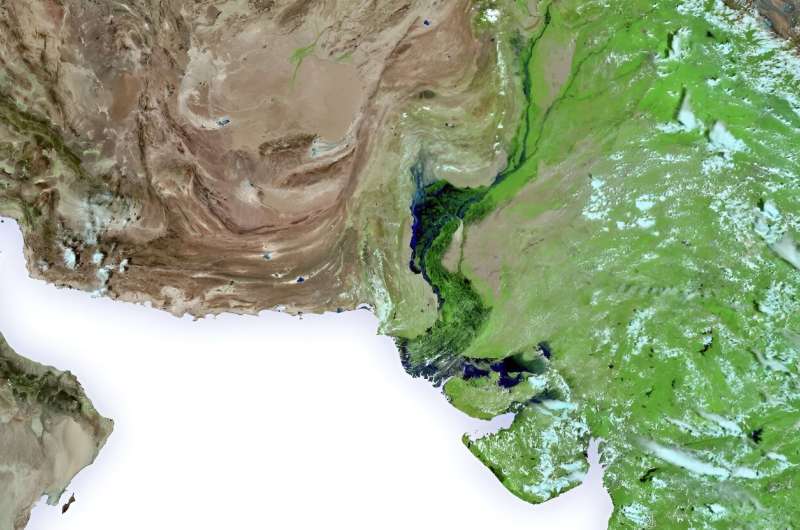This article has been reviewed according to Science X's editorial process and policies. Editors have highlighted the following attributes while ensuring the content's credibility:
fact-checked
peer-reviewed publication
trusted source
proofread
New study reveals the influence of natural climate drivers on extreme monsoons in Pakistan

A new study by researchers at the Department of Energy's Oak Ridge National Laboratory looks at some of the influences that could be driving the increasingly severe weather over Pakistan.
Published in npj Climate and Atmospheric Science, the study analyzed more than 40 years of data and found that natural climate variability, which includes factors such as sea surface temperature and jet stream anomalies, accounts for over 70% of observed monsoon variability and extremes in Pakistan during the 21st century—with climate change potentially adding to their severity.
Pakistan is no stranger to floods and droughts. However, these events have become more frequent and severe in recent decades—unprecedented rainfall in 2010 and 2022 caused catastrophic floods and landslides, and a drought at the beginning of the 21st century caused widespread famine.
Climate scientists must quantify the influence of natural climate variability on these extreme weather events to understand how and the extent to which climate change has contributed to this increased volatility.
The study, titled "The influence of natural variability on extreme monsoons in Pakistan," focused on precipitation variability in West South Asia, a region that includes Pakistan and parts of India. The South Asian climate is commonly studied due to the area's high population and strong monsoon season, which can bring up to 70% of the annual rainfall in a few months.
The region is strongly affected by the pattern of sea temperature changes in the Pacific Ocean known as the El Niño–Southern Oscillation, or ENSO. However, the areas of Pakistan most recently impacted by extreme monsoons typically receive very little rain during the summer, as rain-producing low-pressure systems dissipate by the time they reach the region. The severity of monsoon flooding in Pakistan in 2010 and 2022 suggests that extraordinary atmospheric conditions beyond ENSO have influenced recent weather patterns.
"We know that floods and droughts occur naturally in this region," said Moetasim Ashfaq, a computational climatologist at ORNL and lead author of the study. "Our motivation was to understand what is causing the change in their intensity. Is it natural variability or climate change or both?"
To explore this question, the research team analyzed detrended monthly monsoon precipitation data from West South Asia as well as global land and ocean surface temperatures. Detrending removes large data trends, such as those driven by increasing global temperatures, that may obscure additional factors contributing to changing cyclical patterns.
The team's analysis identified a combination of oceanic and atmospheric factors that impact the precipitation in Pakistan—including ENSO and sea surface temperatures in the western Pacific and northern Arabian Sea—and internal atmospheric variability related to jet stream meandering, which is largely responsible for weather systems moving farther west over Pakistan.
The analysis showed that the influence of these climate factors has increased during the 21st century, which Ashfaq suggests is due to their increased strength, simultaneous occurrence (called co-occurrence) or a combination of both.
The co-occurrence of forcings has a particularly strong influence on precipitation variability, Ashfaq said. For example, when a moderate ENSO occurs with other forcings, such as jet stream meandering, it can impact precipitation in West South Asia more significantly than when it occurs alone. This phenomenon could explain why ENSO was more influential during the 2010 and 2022 flooding events.
Although natural climate variability can explain more than 70% of the precipitation variability over Pakistan, Ashfaq explained that climate change may still play an indirect role. The increased variabilities in jet stream and sea surface temperatures and co-occurrence of multiple forcings may be caused by climate change. Additionally, more atmospheric moisture caused by warmer global temperatures can lead to heavier rainfall, especially when combined with other dynamic forcings. However, further research is necessary to fully understand the impact of climate change on monsoons in Pakistan.
"The link between climate change and extreme weather should be carefully evaluated," Ashfaq said. "Climate change may have an indirect role in shaping the changes in the characteristics of identified forcings, but they're all part of naturally occurring variability in the atmosphere and the oceans."
Some of the identified mechanisms related to the internal atmospheric variability that influences monsoon extremes over Pakistan are less predictable, so forecasts of such events may be limited, Ashfaq said. For example, seasonal forecasting systems predicted above-normal monsoon rains over West South Asia for 2022, but the actual rainfall significantly exceeded the predicted amounts. Nevertheless, the insights into the natural climate drivers that impact summer precipitation at the western margins of the South Asian monsoon region could help future investigations of surrounding regions and the development of better predictive models.
More information: Moetasim Ashfaq et al, The influence of natural variability on extreme monsoons in Pakistan, npj Climate and Atmospheric Science (2023). DOI: 10.1038/s41612-023-00462-8
Journal information: npj Climate and Atmospheric Science
Provided by Oak Ridge National Laboratory




















